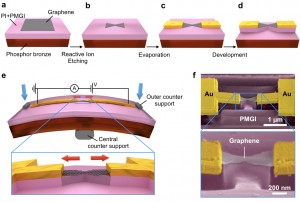MEP-GrMCBJ
MEP Project – van der Zant/Dekker Labs
Single-Biomolecule Sensing in Graphene Tunnel Junctions
Introduction
Nanogaps separating two electrodes are envisaged as the basis for the next generation of molecular fingerprinting technologies. The aim is to exploit quantum electron tunneling as the sensing principle, in which the electronic structure of the target molecule trapped in the nanogap is directly probed. This approach allows the distinction of biomolecules with minute chemical differences (e.g. biomarkers). Graphene combines many of the requisites for an electrical sensor material: high conductivity, atomic thinness, chemical inertness in air and liquid, and mechanical strength, as well as its compatibility with standard lithographic patterning techniques.
Aim

The project will be the first to use mechanically controlled break junctions (MCBJs) based on graphene electrodes to study the charge transport across graphene-biomolecule-graphene junctions. The graphene edges will be functionalized to specifically bind biomolecules (e.g. amino acids and proteins) in order to extract their electronic fingerprint i.e., recognition tunnelling. Particular strengths of graphene MCBJs are (i) the tunability of the gap size at the nanometer scale and (ii) the statistically significant datasets that can be obtained for a single junction (>2,000 conductance traces). This approach is unique and largely unexplored from an experimental standpoint, and will lead to advances in fundamental physics in graphene nanoconstrictions as well as being a novel platform for molecular diagnostics.
Project details
- We are looking for a highly motivated master student to join the van der Zant and Dekker labs, working at the crossroads of quantum charge transport and single-molecule biophysics.
- You will acquire a diverse range of skills including nanofabrication and characterization with state-of-the-art equipment at the Kavli NanoLab cleanroom (ebeam lithography, reactive ion etching, metal evaporation, graphene transfer, SEM, Raman spectroscopy etc.)
- You will be involved in transport measurements in mechanical break junction setups (room temperature, low temperature, in liquid) and in statistical analysis of the spectroscopic data.
- This timely and challenging project between the departments of Quantum and BioNanoscience has a large experimental character and scope for high impact publications.
Please contact Sabina Caneva (s.l.caneva@[TUD])
